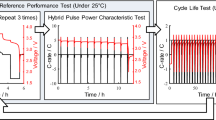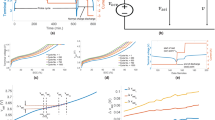Abstract
Terminal voltage is an important indicator to alarm end-of-discharge of lithium-ion batteries. Therefore, predicting the terminal voltage is helpful in preventing issues that caused by running out of power. However, the loading condition of battery is usually dynamic in real practice which greatly increases the difficulty of prediction. In this paper, we propose a novel approach to predict the terminal voltage under dynamic loading condition. This approach transforms the problem of predicting the terminal voltage into the problem of predicting the state-of-charge (SOC) of battery, using equivalent circuit model and a polynomial function. In the prediction of SOC, an accurate value of capacity is required, but it is not practical to be measured in each discharge process. Therefore, we develop an adaptive capacity method based on feature extraction in charging profile and k-nearest neighbor algorithm to timely update batterys SOC after each charge process. The whole prediction approach is tested on an open dataset, and comparison experiments demonstrate that it outperforms traditional approaches.












Similar content being viewed by others
References
Amiribesheli M, Benmansour A, Bouchachia A (2015) A review of smart homes in healthcare. J Ambient Intell Humaniz Comput 6(4):495–517
Chen FG, Liu X, Rui LI, Liu XL (2016) The soc prediction of li-ion battery based on optimized elm neural network. Movable Power Stat Veh 1:18–22
Cheng Y, Lu C, Li T, Tao L (2015) Residual lifetime prediction for lithium-ion battery based on functional principal component analysis and Bayesian approach. Energy 90:1983–1993
Domenico DD, Fiengo G, Stefanopoulou A (2008) Lithium-ion battery state of charge estimation with a kalman filter based on a electrochemical model. In: IEEE international conference on control applications, pp 702–707
Guo Y, Zhao Z, Huang L (2017) SOC estimation of lithium battery based on improved BP neural network. Energy Procedia 105:4153–4158
Hu X, Li S, Peng H (2012) A comparative study of equivalent circuit models for Li-ion batteries. J Power Sources 198(198):359–367
Kong SN, Moo CS, Chen YP, Hsieh YC (2009) Enhanced coulomb counting method for estimating state-of-charge and state-of-health of lithium-ion batteries. Appl Energy 86(9):1506–1511
Li L, Wang P, Chao KH, Zhou Y, Yang X (2016) Remaining useful life prediction for lithium-ion batteries based on gaussian processes mixture. Plos One 11(9):e0163,004
Luo Y, Luo Y, Liu J, Peng Y, Guo L, Pecht M (2014) Lithium-ion battery remaining useful life estimation based on fusion nonlinear degradation AR model and RPF algorithm. Neural Comput Appl 25(3–4):557–572
Mirzapour F, Lakzaei M, Varamini G, Teimourian M, Ghadimi N (2017) A new prediction model of battery and wind-solar output in hybrid power system. J Ambient Intell Humaniz Comput 6:1–11
Orchard ME, Cerda M, Olivares B, Silva JF (2012) Sequential monte carlo methods for discharge time prognosis in lithium-ion batteries. Int J Prognostics Health Manag 3(2):1–12
Pattipati B, Sankavaram C, Pattipati K (2011) System identification and estimation framework for pivotal automotive battery management system characteristics. IEEE Trans Syst Man Cybern Part C 41(6):869–884
Rahman MA, Anwar S, Izadian A (2016) Electrochemical model parameter identification of a lithium-ion battery using particle swarm optimization method. J Power Sources 307:86–97
Ramadan HS, Becherif M, Claude F (2017) Extended kalman filter for accurate state of charge estimation of lithium-based batteries: a comparative analysis. Int J Hydrogen Energy 42(48):29033–29046
Rampone S, Valente A (2016) Prediction of seasonal temperature using soft computing techniques: application in Benevento (southern Italy) area. J Ambient Intell Humaniz Comput 8(1):1–8
Saha B, Goebel K (2009) Modeling Li-ion battery capacity depletion in a particle filtering framework. https://www.researchgate.net/profile/Kai_Goebel/publication/284154682_Modeling_Liion_battery_capacity_depletion_in_a_particle_filtering_framework/links/5669f23208ae1a797e3782e5/Modeling-Li-ion-battery-capacity-depletion-in-a-particle-filtering-framework.pdf?origin=publication_detail
Santos RMS, Alves CLGDS, Macedo ECT, Villanueva JMM, Hartmann LV, Catunda SYC (2017) Lead acid battery soc estimation based on extended kalman filter method considering different temperature conditions. In: IEEE International Instrumentation and Measurement Technology Conference, pp 1–6
Schalkwijk WAV, Scrosati B (2002) Advances in lithium-ion batteries. Kluwer Academic/Plenum, Dordrecht
Tao L, Ma J, Cheng Y, Noktehdan A, Chong J, Lu C (2017) A review of stochastic battery models and health management. Renew Sustain Energy Rev 80:716–732
Tian Y, Xia B, Sun W, Xu Z, Zheng W (2014) A modified model based state of charge estimation of power lithium-ion batteries using unscented Kalman filter. J Power Sources 270(3):619–626
Wang S, Fernandez C, Shang L, Li Z, Li J (2017) Online state of charge estimation for the aerial lithium-ion battery packs based on the improved extended kalman filter method. J Energy Storage 9:69–83
Wang Y, Zhang C, Chen Z (2015) A method for state-of-charge estimation of lifepo 4 batteries at dynamic currents and temperatures using particle filter. J Power Sources 279(ISSN):306–311
Wang Y, Zhang C, Chen Z (2016) An adaptive remaining energy prediction approach for lithium-ion batteries in electric vehicles. J Power Sources 305:80–88
Widodo A, Shim MC, Caesarendra W, Yang BS (2011) Intelligent prognostics for battery health monitoring based on sample entropy. Expert Syst Appl Int J 38(9):11,763–11,769
Xia B, Sun Z, Zhang R, Lao Z, Xia B, Sun Z, Zhang R, Lao Z (2017) A cubature particle filter algorithm to estimate the state of the charge of lithium-ion batteries based on a second-order equivalent circuit model. Energies 10(4):1–15
Yang N, Zhang X, Li G (2015) State of charge estimation for pulse discharge of a liFePO4 battery by a revised Ah counting. Electrochim Acta 151:63–71
Yang D, Wang Y, Pan R, Chen RY, Chen Z (2017) State-of-health estimation for the lithium-ion battery based on support vector regression. Appl Energy. https://doi.org/10.1016/j.apenergy.2017.08.096
Ye M, Guo H, Cao B (2017) A model-based adaptive state of charge estimator for a lithium-ion battery using an improved adaptive particle filter. Appl Energy 190:740–748
Yu J, Liang S, Tang D, Liu H (2017a) Remaining discharge time prognostics of lithium-ion batteries using dirichlet process mixture model and particle filtering method. IEEE Trans Instrum Meas 66(9):2317–2328
Yu J, Mo B, Tang D, Liu H, Wan J (2017b) Remaining useful life prediction for lithium-ion batteries using a quantum particle swarm optimization-based particle filter. Qual Eng 29(5):536–546
Yu J, Mo B, Tang D, Yang J, Wan J, Liu J (2017c) Indirect state-of-health estimation for lithium-ion batteries under randomized use. Energies. https://doi.org/10.3390/en10122012
Zhang J, Lee J (2011) A review on prognostics and health monitoring of Li-ion battery. J Power Sources 196(15):6007–6014
Zhang X, Miao Q, Liu Z (2017) Remaining useful life prediction of lithium-ion battery using an improved upf method based on MCMC. Microelectron Reliab 75:288–295
Author information
Authors and Affiliations
Corresponding author
Additional information
Publisher's Note
Springer Nature remains neutral with regard to jurisdictional claims in published maps and institutional affiliations.
Rights and permissions
About this article
Cite this article
Yu, J., Tang, W., Tang, D. et al. An approach to predicpt discharge voltage of lithium-ion batteries under dynamic loading conditions. J Ambient Intell Human Comput 10, 923–936 (2019). https://doi.org/10.1007/s12652-018-0908-y
Received:
Accepted:
Published:
Issue Date:
DOI: https://doi.org/10.1007/s12652-018-0908-y




